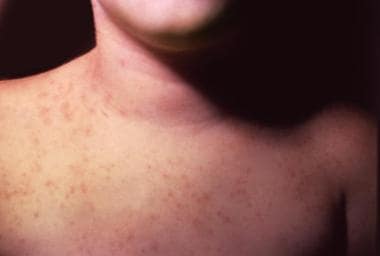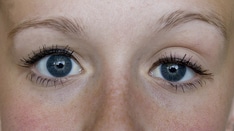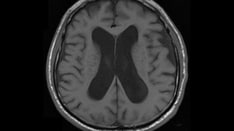Background
Pediatric aseptic meningitis is an inflammation of the meninges caused mainly by nonbacterial organisms, specific agents, or other disease processes. Aseptic meningitis (including viral meningitis) is the most common infection of the central nervous system (CNS) in the pediatric population, occurring most frequently in children younger than 1 year. Despite advances in antimicrobial and general supportive therapies, CNS infections remain a significant cause of morbidity and mortality in children.
Because the classic signs and symptoms are often absent, especially in younger children, diagnosing pediatric CNS infections is a challenge to the emergency department (ED). Even when such infections are promptly diagnosed and treated, neurologic sequelae are not uncommon. Clinicians are faced with the daunting task of distinguishing the relatively few children who actually have CNS infections from the vastly more numerous children who come to the ED with less serious infections.
Pathophysiology
Organisms colonize and penetrate the nasopharyngeal or oropharyngeal mucosa, survive and multiply in the blood stream, evade host immunologic mechanisms, and spread through the blood-brain barrier. Infection cannot occur until colonization of the host has taken place (usually in the upper respiratory tract). The mechanisms by which circulating viruses penetrate the blood-brain barrier and seed the cerebrospinal fluid (CSF) to cause meningitis are unclear.
Viral infection causes an inflammatory response but to a lesser degree than bacterial infection does. Damage from viral meningitis may be due to an associated encephalitis and increased intracranial pressure (ICP).
The pathophysiology of aseptic meningitis caused by drugs is not well understood. This form of meningitis is infrequent in the pediatric population.
Etiology
Although many agents and conditions are known to be associated with pediatric aseptic meningitis, often a specific cause is not identified, because a complete diagnostic investigation is not always completed. Viruses are the most common cause, and enteroviruses (EVs) are the most frequently detected viruses. The use of molecular diagnostic techniques (eg, polymerase chain reaction [PCR] assay) has significantly increased diagnostic accuracy.
Viruses
EV is a frequent cause of febrile illnesses in children and is frequently found in asymptomatic children. [1] Other viral pathogens include human parechovirus, paramyxovirus, herpesvirus, influenza virus, rubella virus, and adenovirus. Meningitis may occur in as many as 50% of children younger than 3 months with EV infection. EV infection can occur at any time during the year but is associated with epidemics in the summer and fall.
Viruses associated with aseptic meningitis include the following:
Enteroviruses species A-D: this encompasses enterovirus, echoviruses, coxsackie viruses and polio viruses. [2]
Enterovirus A: EV-A71 and Coxsackie A2-8, 10, 12, 14, 16
Enterovirus B: EV-B75, Coxsackie B1-6, Echovirus 1-33, [3]
Enterovirus C: Poliovirus 1-3, Coxsackie A 1, 11, 13, 17, 19-24,
Enterovirus D: EV –D68, 70 [4]
Human parechoviruses (HPeV) (16 serotypes; HPeV types 1 and 2 were previously classified as echovirus types 22 and 23 within the genus Enterovirus), type 3 (and less commonly type 5) has been associated with childhood CNS infections. [5, 6, 7]
Arbovirus (eastern, western, and Venezuelan equine encephalitis viruses; Powassan virus; California group viruses [primarily LaCrosse virus]; St. Louis encephalitis virus; West Nile virus; and Colorado tick fever)
Mumps virus
Herpes simplex virus (HSV) types 1 and 2
Human herpesvirus type 6 (HHV6) and type 7 (HHV7)
Varicella-zoster virus (VZV)
Adenovirus types 3 and 7
Human immunodeficiency virus (HIV)
Lymphocytic choriomeningitis (associated with contact with guinea pigs, hamsters, and pet mice)
Influenza A and B viruses, including H1N1 [8, 9]
Parainfluenza virus
Rotavirus
Coronavirus
Variola virus
Flavivirus [10]
Toscana Virus [11]
Skin lesions due to echovirus type 9 on neck and chest of young girl. Echoviruses belong to genus Enterovirus and are associated with illnesses including aseptic meningitis, nonspecific rashes, encephalitis, and myositis.
 Skin lesions due to echovirus type 9 on neck and chest of young girl. Echoviruses belong to genus Enterovirus and are associated with illnesses including aseptic meningitis, nonspecific rashes, encephalitis, and myositis.
Skin lesions due to echovirus type 9 on neck and chest of young girl. Echoviruses belong to genus Enterovirus and are associated with illnesses including aseptic meningitis, nonspecific rashes, encephalitis, and myositis.
Viral vaccines
Viral vaccines related to aseptic meningitis include the following:
Mumps vaccine [12]
Measles-mumps-rubella (MMR) vaccine
Polio vaccine
Yellow fever vaccine [13]
Nonpyogenic bacteria
Certain bacterial infections may give rise to aseptic meningitis (eg, partially treated bacterial meningitis or brain abscess). Nonpyogenic bacteria associated with aseptic meningitis include the following:
Treponema pallidum
Borrelia (relapsing fever, Lyme disease)
Bartonella
Atypical mycobacteria
Brucella
Other organisms
Atypical organisms associated with aseptic meningitis include the following:
Parasites associated with aseptic meningitis include the following:
Roundworms
Tapeworms
Flukes
Amoebae
Fungal meningitis is rare but may occur in immunocompromised patients; children with cancer, previous neurosurgery, or cranial trauma; or premature infants with low birth rates. Most cases occur in children who are inpatients receiving antibiotic therapy. Fungi associated with aseptic meningitis include the following:
Cryptococcus
Additional organisms associated with aseptic meningitis include the following:
Blastomyces dermatitidis
Coccidioides immitis
Alternaria species
Aspergillus species
Cephalosporium species
Cladosporium trichoides
Drechslera hawaiiensis
Paracoccidioides brasiliensis
Petriellidium boydii
Sporotrichum schenckii
Ustilago species
Zygomycetes species
Diseases and other conditions or events
Diseases associated with aseptic meningitis include the following:
Leukemia
Behçet disease
Systemic lupus erythematosus (SLE)
Sjögren syndrome [14]
Dermoid and epidermoid cysts [15]
CNS tumor
Recurrent benign endothelioleukocytic aseptic meningitis (Mollaret meningitis) [17]
Neonatal-onset multisystem inflammatory disorder (one of the cryopyrin-associated periodic syndromes [CAPS]) [18]
Other conditions or events associated with aseptic meningitis include the following:
Immunoglobulin replacement therapy
Heavy metal poisoning
Intrathecal agents
Foreign bodies (eg, shunt or reservoir)
Drugs
Epidemiology
United States Statistics
The incidence of aseptic meningitis in the United States has been estimated to be approximately 75,000 cases per year. Before the introduction of the MMR vaccine program, the mumps virus was the most common cause, accounting for 5-11 of 100,000 cases of meningitis; it now accounts for approximately 0.3 of 100,000 cases, and EV has become the most common cause. In a North American study from 1998-1999, most cases occurred between July and October. [19]
International Statistics
In the United Kingdom, the causes of meningitis have changed since the introduction of vaccines against Haemophilus Influenza B (1992) Neisseria Meningitidis (1999) and Streptococcus Pneumoniae (2006). [20] Viruses are the predominate known cause of meningitis but 41% of patients with meningitis had no identifiable pathogen. During a similar time period in the United Kingdom, admission rates for viral meningitis fell by almost two thirds following the introduction of the MMR vaccine. [21] Prior to the vaccine mumps meningitis was likely the leading cause of viral meningitis. Following its introduction, peaks in admissions were noted in association with known outbreaks of Echovirus 13 and 30. The overall decline in admissions was due to a fall in admissions in those age 1-14 years. Admissions with viral meningitis in those < 3 months has risen in recent years however this may be due to differences in clinical practice. Furthermore there were biannual peaks in admissions for infants < 3 months which may reflect the biannual spring time peaks reported in HPeV infections. [22] The proportion of cases recognized as being caused by enterovirus also rose which could be attributed partially but not wholly to improved detection.
The Austrian reference laboratory for poliomyelitis received 1,388 stool specimens for EV typing from patients with acute flaccid paralysis or aseptic meningitis between 1999 and 2007; 201 samples from 181 cases were positive for nonpoliomyelitis EV. [23] The mean patient age was 5-6 years, with 90% of cases in children younger than 14 years. Aseptic meningitis was identified in 65.6% of the cases. Echovirus 30 (E-30) was the most frequent viral cause of aseptic meningitis, due to an epidemic in 2000, followed by coxsackievirus B types 1-6 and EV 71. E-30 was also the leading viral pathogen in a Spanish study of aseptic meningitis. [3]
A new outbreak of E-30 occurred between April and September 2013 in Marseille, South-East France. A study concluded that almost all E-30 emerged from local circulation of one parental virus. The findings also showed that human enterovirus outbreaks cause an excess of emergency ward consultations but probably also an excess of consultations to general practitioners who receive majority of the non-specific viral illness. [24] Similar outbreaks have been reported in California, Germany, Finland, Italy and China. [25, 26, 27, 28, 29]
Outbreaks of meningitis caused by other types of enteroviruses also occur when new genetic variants develop. [30, 31]
Human parechovirus (HPeV) is an increasingly recognized viral cause of aseptic meningitis. [7] Studies have shown that in young infants (< 3 months) HPeV is as least as common as enterovirus. [6] 16 types have been identified with types 1-8 being the most studied. In the pediatric population type 3 has been shown to cause meningitis and neonatal sepsis. [32] The other types are associated with gastroenteritis and respiratory illness. [6] Diagnostic assays for HPeV are not widely available and so its burden is thought to be underestimated. [5]
In an area of Southwestern Norway, where Lyme disease is endemic, it is the leading cause of meningitis. [33]
Age-related demographics
Aseptic meningitis is more common in children than in adults. [34] This reflects increased frequency of enteroviral infections in children. [35] Rates of enterovirus and HPeV in young infants have risen which may reflect reduced maternal seroprevalence and reduced transfer of maternal antibodies to the newborn. [36] In the UK admission rates for children with viral meningitis have fallen since the introduction of the MMR vaccine however rates have risen in infants under 1 year of age.
Sex-related demographics
Studies have shown a male predilection in aseptic meningitis. 59% of pediatric patients in a Texan study were male while a Greek study showed a male:female ratio of 1.8:1. [34, 37] Further studies in South Korea and Japan have also demonstrated higher proportion of males affected. [38, 39]
Race-related demographics
In the Texan study adults with aseptic meningitis were more likely to be Caucasian and children were more likely to be Hispanic. [37] No background demographic data was provided therefore the significance of this is uncertain.
Prognosis
Full recovery is usual after uncomplicated viral aseptic meningitis. Most cases resolve within 7-10 days.
Recurrence is possible (known as Mollaret, or benign recurrent meningitis). Associated viruses include Epstein-Barr virus (EBV), coxsackieviruses B5 and B2, echoviruses 9 and 7, herpes simplex virus (HSV)-1 and HSV-2, and human immunodeficiency virus (HIV).
Overall mortality and morbidity for aseptic meningitis are unclear. In a Taiwanese study of EV 71 infections, 78 of 408 hospitalized children died and among the children with rhombencephalitis due to EV infection, 14% died. [40]
Subsequent studies suggested better outcomes. No deaths have been reported in Canadian, Korean, Greek and American studies. [38, 19, 34, 37] Overall, it is felt that there are no or minimal long term effects however there is a lack of data regarding long term morbidity and psychological impact.
Patient Education
For more information, visit the Meningitis Foundation of America Web site. The Meningitis Research Foundation offers useful material for nonexperts, parents, and health care professionals.
-
Skin lesions due to echovirus type 9 on neck and chest of young girl. Echoviruses belong to genus Enterovirus and are associated with illnesses including aseptic meningitis, nonspecific rashes, encephalitis, and myositis.







